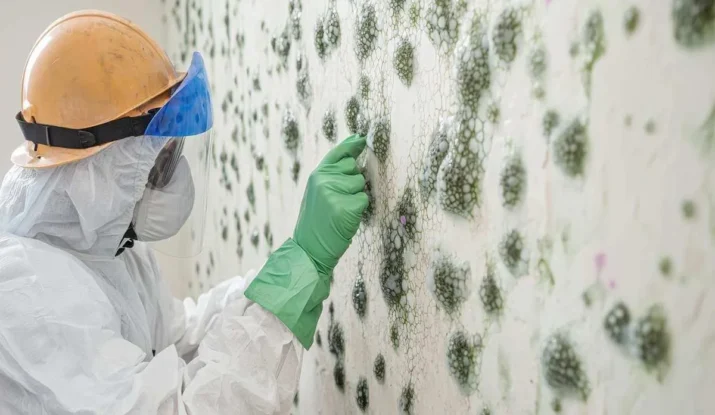You are enjoying a crisp fall morning in your Boston home, enjoying the weather and sipping coffee. Suddenly, you discover dark spots creeping along your living room’s wall, where it meets the floor.
You assume they’re dirt stains, but upon closer inspection, you realize what you suspected. It’s mold. That silent, smelly, and unsightly growth that you love to hate.
Mold can threaten your home’s air quality, cause health issues, and damage the structure. Boston, with its humid coastal weather and older homes, is prone to mold growth. That is why mold detection becomes crucial, not a choice.
Why Mold is a Hidden Threat in Boston Homes
Boston has an ideal climate for mold to thrive. It experiences four seasons: a snowy winter and a damp, humid summer, resulting in frequent and massive moisture shifts. And where there is moisture, mold will follow.
Many of Boston’s neighborhoods, like Dorchester, Jamaica Plain, and the South End, have homes that are over 50 years old. Older buildings are favorite breeding grounds for mold because they have inadequate ventilation, worn-out plumbing, and foundation cracks. All these factors work in favor of mold growth, giving a tough time to Boston residents.
Indoor mold growth is fast. It can start within 24 to 48 hours after a moisture event caused by a leak or flood. Before you know it, it begins damaging your home.
The Real Dangers of Mold
Mold isn’t just ugly to look at. It has serious health implications. It can also reduce your home’s value and undermine its structural integrity.
Health Risks Include
- Sneezing, coughing, itchy and watery eyes.
- Respiratory issues, especially in asthma patients.
- Skin irritation or headaches.
- Sustained exposure to mold is particularly risky for children and the elderly.
The CDC confirms that mold exposure can worsen asthma and trigger breathing difficulties in individuals with weakened immune systems.
Structural Damage
Mold also eats away at wood, drywall, and insulation. If left unchecked, it can:
- Weakened walls and ceilings.
- Spread musty odors.
- Damage floors and carpets.
- Require costly professional remediation.
The Power of Early Mold Detection
With so much at stake, catching mold early is crucial. It can save you money, mental stress, and, of course, money. Early mold detection helps you solve the problem before it gets out of hand and causes some serious damage.
It’s the same as treating a cold early; if left untreated, it can turn into pneumonia.
When detected early, mold removal is less troubling and may only involve:
- A simple scrub with antimicrobial solutions.
- Fixing a minor leak.
- A dehumidifier can be used to snuff out humidity and dry the area.
Ignore the problem and be prepared for some major tearing and repairing.
Signs You Might Need a Mold Detection Test
Sometimes mold is visible; other times, it is not. Hidden behind walls, under floors, or in the attic, it becomes hard to detect and requires an extensive mold detection test.
Here are some red flags to look out for:
- A musty or earthy smell in certain rooms.
- Water leaks or recent flooding.
- Discoloration on walls, ceilings, or baseboards.
- Peeling paint and water stains on the walls.
- Health symptoms that improve when you leave the house.
- Excess humidity indoors, especially in basements or bathrooms.
Don’t ignore these signs in your Boston home. They demand action. Hire an expert to get a mold detection test to identify its location and its extent.
Mold Detection Methods Used by Professionals
DIY kits exist, but they are not very effective. Professional mold inspectors use advanced tools and scientific methods to accurately assess your home.
Common Mold Detection Techniques
They usually include the following:
- Air sampling: It measures airborne mold spores and compares indoor vs. outdoor levels.
- Surface testing: For visible mold to determine its type and growth stage.
- Moisture meters: They identify damp areas behind walls or under floors.
- Infrared cameras: Spot temperature changes that may indicate hidden moisture.
These methods will keep you at ease in a city like Boston, where moisture intrusion is a frequent problem due to melting snow or aging roofing.
Why Boston Residents Should Act Quickly
Boston has a strict building code. Lands and property managers can face legal consequences if mold becomes a serious health issue. For homeowners, mold can impact insurance claims and reduce your home’s resale value.
Additionally, in vintage homes and buildings, preservation matters. If the mold gets into antique woodwork or historical finishes, restoration becomes costlier and more complicated.
Tips to Prevent Mold Growth
Early mold detection is vital, but prevention is always better than a cure. Here’s how you can keep mold at bay in your Boston home:
- Dehumidifiers are your best friends in basements and bathrooms.
- Kitchens and laundry rooms should have adequate ventilation.
- Fix leaks whenever and wherever they occur.
- Gutters should be cleaned to prevent water pooling.
- Insulate cold surfaces like windows and pipes to reduce condensation.
Conclusion: Don’t Wait Until It’s Too Late
Mold doesn’t discriminate in your home in Beacon Hill or Brighton. It thrives in moist conditions and spreads silently, often in inaccessible areas. For Boston homeowners, early mold detection is not a luxury; it’s a necessity.
Catching mold early protects your health, your investment, and your peace of mind.
At RJ Home Inspections, we understand the unique challenges of Boston homes. Our certified team uses innovative tools and methods to provide accurate and reliable mold detection services. Don’t hesitate to contact us; we’re here to help.
Fix that musty smell before it becomes a full-blown problem. Book your professional mold detection test with RJ Home Inspections today, and don’t let mold take root in your home. Don’t let mold take possession of your home.

